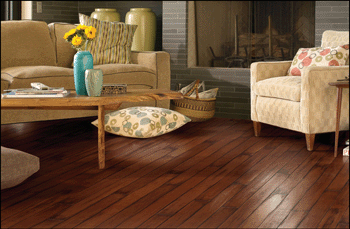 |
| Mannington’s Knightsbridge. |
|
By Matthew Spieler
Americans have always been a nostalgic bunch—classic rock, classic cars, Classic Coke and, in recent years, classic home furnishings that include wood floors.
Rustic, handscraped, distressed or whatever term you want to apply, the fact is this type of product is growing by leaps and bounds. So much so that some companies, such as Renaissance Old World, focus only on producing Old World products—from floors to cabinetry and other interior needs.
In fact, at the upcoming Fall High Point Market the first Rustic Pavilion will be launched with Dick Idol, one of the most recognized names in rustic home décor. The 5,000 square foot area will feature several of Idol’s licensing partners showing their wares. “The demand by consumers for this category of home furnishings is increasing,” he said.
“Rustics continue to grow at a very healthy pace, well into the double-digits each year for the past several years,” said Dan Natkin, hardwood product manager for
Mannington Mills. “In particular, our handscraped and distressed products have seen the most significant growth.”
According to industry experts, analysts and
FCNews research, this segment now represents between 30% and 35% of all wood category sales.
John Woolsey, vice president of marketing and merchandising for
Anderson Hardwood Floors, noted, “Rustic choices today account for over one-third of our offerings, an even higher percentage of our unit and dollar sales, and continue to grow in volume and popularity.”
Interestingly, like many great advances, this “rash of rustics” started by accident. Up until the mid 1990s, wood floors were, in a sense, perfect—think of No. 1 Oak. In other words, first quality or clear grade meant no knots, shade variations or mineral streaks. Boards containing “defects” were given labels such as character grade or cabin grade and were sold at substantial discounts just to unload them.
Then something strange happened. Woolsey reflects that
Don Finkell, Anderson’s president, went to visit a commercial customer in New York who was seeking a lower price. He brought with him a mixed bag of boards—from clear grade pieces to ones with rustic defects. The client did not want the “defective” boards.
Back at his office, Finkell put the cabin grade pieces on his desk where they lay when a group of designers from Southern California came for a visit. “It was love at first sight,” as Woolsey puts it, and thus was born Anderson’s Mountain Series and the beginning of the rustic movement. In 2001, the company introduced the first handscraped hardwood floor, Virginia Vintage.
Others agree the movement started out West but has quickly spread throughout the country. “The rustics trend—if you can even still call it a trend—really began in the South and the West,” Natkin said, “but its popularity has now expanded into all regions.”
Mike Kearins, president of Pinnacle Floors, added, “Initially, the majority of our sales in this category were in the southern tier of the country—from East to West. As the category has gained popularity and we have added additional handscraped products in solid wood, we have seen both interest and sales grow in the traditional solid markets as well.”
Woolsey concurred these products helped open new markets for Anderson. “Rustic flooring has been our entry into Northern markets that once were 100% solid and opened them up to our engineered offerings. Today, rustic sales drive our business in every region of the country.”
More options
As for what is being offered, manufacturers say that while the tradional species—oak, maple, hickory and cherry—continue to make up the bulk of rustic looks, more options are coming online as consumers’ overall tastes in wood looks expand.
“As with traditional smooth faced hardwood flooring, the most popular species remain,” explained Kearins, “but we are also seeing an increase in requests for exotic species with a handscraped surface.”
Woolsey added, “There is no question the hottest markets in hardwood now are handscraped and exotic. And, it should come as no surprise that manufacturers like Anderson would find a way to combine the two into one product.”
Even though rustic products are made to look worn and old, when they were first introduced, many were priced higher than typical first grade products. Today, there are products for every price point, though companies warn that like with every other low-end product, buyer beware.
“Over the last few years,” said Kearins, “there have been numerous brokers importing non-branded handscraped products into the U.S. at prices in every range. The high-end products are still around and doing well, but as with any ‘new’ product it didn’t take long for cost-cutting measures to be implemented in order to be able to offer this style to a wider range of customer budgets.”
Mannington’s Natkin added, “This is one of the challenges of a category that’s defined by its unique visuals—the price point can become squeezed by competition from lower-end imports. That said, however, we don’t anticipate this to have a long-term negative impact. Consumers are very savvy and quickly recognize that style does not equal quality, and companies need to provide both of those things to be successful in the long run.”
Kearins concluded, “With more global sources arising every day, it is worth thoroughly investigating your options. There will always be a product with a price point that is lower than the last guy, but what has been compromised to achieve that—quality, consistency, availability or warranty? Will that source be there tomorrow if you have a problem, and is your reputation worth saving a few cents?”